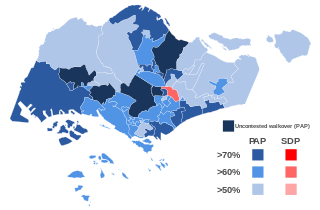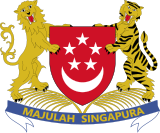
Lee Kuan Yew, often referred to by his initials LKY, was a Singaporean statesman and lawyer who served as the first Prime Minister of Singapore from 1959 to 1990, as well as Secretary-General of the People's Action Party from 1954 to 1992. He was the Member of Parliament (MP) for Tanjong Pagar from 1955 until his death in 2015. Lee is widely recognised as the founding father of the modern Singaporean state, and for his leadership in turning it into a highly developed country under his tenure.

The People's Action Party is a major conservative centre-right political party in Singapore and one of three contemporary political parties represented in Parliament, alongside the opposition Workers' Party (WP) and Progress Singapore Party (PSP).

Barisan Sosialis was a political party in Singapore. It was formed on 29 July 1961 and officially registered on 13 August 1961 by left-wing members of the People's Action Party (PAP) who had been expelled from the PAP. The prominent founding members of the Barisan were Lee Siew Choh and Lim Chin Siong. It became the biggest opposition party in Singapore in the 1960s and the 1980s.

Lim Chin Siong was a Singaporean politician and union leader active in Singapore in the 1950s and 1960s. He was one of the founders of the governing People's Action Party (PAP), which has governed the country continuously since independence. Lim also used his popularity to galvanise many trade unions in support of the PAP.

Operation Coldstore was the code name for a covert security operation executed in Singapore on 2 February 1963 which led to the arrest of 113 people, who were detained without trial pursuant to the Preservation of Public Service Security Ordinance (PSSO). In official accounts, the operation was a security operation "aimed at crippling the Communist open front organisation," which threatened Singapore's internal security. The operation was authorised by the Internal Security Council which was composed of representatives from the British government, Singaporean government, and the Malayan Federal government.

General elections were held in Singapore on 21 September 1963, five days after Singapore became part of Malaysia. Voters elected all 51 members of the Legislative Assembly. The elections were the only ones to date with no boundary changes to any existing constituencies prior to the elections. The result was a victory for the People's Action Party (PAP), which won 37 of the 51 seats, while the majority of the remaining seats were won by Barisan Sosialis (BS).

The Singapore People's Alliance was a political coalition in Singapore founded in 1958, comprising the Labour Front and Liberal Socialist Party. It has never won any seats in the Parliament of Singapore. However, the party did win 4 seats to the Singaporean Legislative Assembly in the general election of 1959 under the leadership of former Chief Minister Lim Yew Hock, with a popular vote of 107,755 or 20.7% of the total number of votes. Following the election, the Liberal Socialist Party merged into it.
The following lists events that happened during 1965 in Singapore.
The following lists events that happened during 1961 in Singapore.

The history of the modern state of Singapore dates back to its founding in the early 19th century; however, evidence suggests that a significant trading settlement existed on the island in the 14th century. The last ruler of the Kingdom of Singapura, Parameswara, was expelled by the Majapahit or the Siamese before he founded Malacca. Singapore then came under the Malacca Sultanate and subsequently the Johor Sultanate. In 1819, British statesman Stamford Raffles negotiated a treaty whereby Johor would allow the British to locate a trading port on the island, ultimately leading to the establishment of the Crown colony of Singapore in 1867. Important reasons for the rise of Singapore were its nodal position at the tip of the Malay Peninsula flanked by the Pacific and Indian Oceans, the presence of a natural sheltered harbour, as well as its status as a free port.

General elections were held in Singapore on 30 May 1959. They were held under the new constitution and were the first in which all 51 seats in the Legislative Assembly were filled by election. This was the first election victory for the People's Action Party (PAP), as they won a landslide victory with 43 seats. The party has remained in power ever since.

The self-governance of Singapore was carried out in several stages. Since the founding of Singapore in 1819, Singapore had been under the colonial rule of the United Kingdom. The first local elections on a limited scale for several positions in the government of Singapore started in 1948 following an amendment to the Constitution of Singapore.

Singapore, officially the State of Singapore, was one of the 14 states of Malaysia from 1963 to 1965. Malaysia was formed on 16 September 1963 by the merger of the Federation of Malaya with the former British colonies of North Borneo, Sarawak and Singapore. This marked the end of the 144-year British rule in Singapore which began with the founding of modern Singapore by Sir Stamford Raffles in 1819. At the time of merger, it was the smallest state in the country by land area, but the largest by population.

General elections were held in Singapore on 3 September 1988. President Wee Kim Wee dissolved parliament on 17 August 1988 on the advice of Prime Minister Lee Kuan Yew. The result was a victory for the People's Action Party, which won 80 of the 81 seats. This was the last time Prime Minister Lee Kuan Yew led the PAP in an election.
Two by-elections were held in 1961. The first by-election, for the Hong Lim constituency, was held on 29 April with the nomination day held on 11 March, while the second by-election, for the Anson constituency, was held on 15 July with the nomination day held on 10 June.
Lim Hock Siew was a Singaporean politician, political prisoner and medical doctor.
The University Socialist Club was a left-wing student group active from 1953 to 1971 that played an important role in the politics of colonial Malaya and post-colonial Malaysia and Singapore. Members of the club played a significant role in bringing independence from the British Empire and in debates over the shape of the post-colonial nation. The club was instrumental in the formation and early success of the People's Action Party (PAP) and later, the Barisan Sosialis Party. Prominent members of the Club included Wang Gungwu, S.R. Nathan, Poh Soo Kai, Sydney Woodhull, Lim Hock Siew, and Tommy Koh and M. K. Rajakumar.
Poh Soo Kai is a Singaporean medical doctor, politician, political prisoner. He was a founding member of the University Socialist Club and the People's Action Party (PAP).
Sandrasegaran "Sidney" Woodhull was a Singaporean lawyer, former politician and political prisoner. He was a founding member of the University of Malaya's University Socialist Club, and the Singapore's political parties, People's Action Party and the Barisan Sosialis.

Thampore Thamby Rajah, better known as T. T. Rajah, was a Singaporean politician and lawyer who served as Secretary-General of the People's Action Party for a short period of time in 1957 before joining the Barisan Sosialis in 1961.













